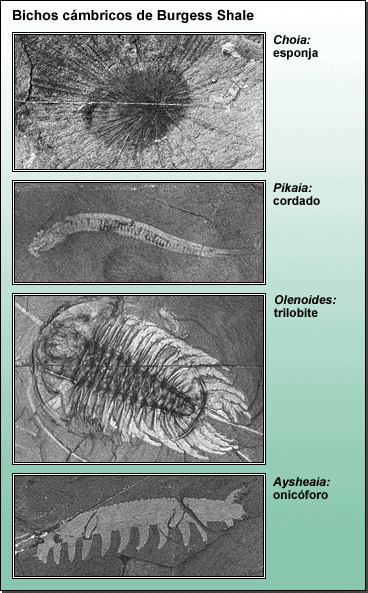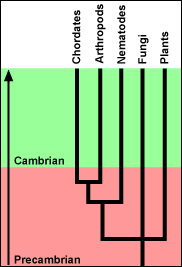Hace aproximadamente 530 millones de años, irrumpió una gran variedad de animales en la escena evolutiva en un suceso conocido como la explosión del Cámbrico. En quizá tan sólo 10 millones de años, los animales marinos desarrollaron la mayor parte de los planes corporales básicos que observamos en los grupos actuales. Entre los organismos que se conservan en fósiles de esta época hay parientes de los crustáceos y las estrellas de mar, esponjas, moluscos, gusanos, cordados y algas, como vemos en el ejemplo de estos taxones de Burgess Shale.


¿Una «explosión»?
El término «explosión» puede ser algo inadecuado, ya que la vida del Cámbrico no evolucionó en un abrir y cerrar de ojos sino que estuvo precedida por muchos millones de años de evolución y muchos de los filos animales en realidad divergieron durante el Precámbrico.
Los animales del Cámbrico no aparecieron por arte de magia; se han encontrado fósiles de animales anteriores al Cámbrico. Hace más o menos 575 millones de años, un extraño grupo de animales conocido como la fauna de Ediacara habitó los océanos y, aunque no sabemos mucho sobre estos animales, puede que hubiera en el grupo antepasados de los linajes que identificamos a partir de la explosión cámbrica.

Teach your students about the Cambrian explosion: Interactive investigation: The arthropod story, a web activity for grades 6-12.
Original translation by the Spanish Society of Evolutionary Biology; translation editing by Maya deVries
Precambrian clade diagram after Wang, D.Y.-C., Kumar, S. & Hedges, S.B. (1999) Divergence time estimates for the early history of animal phyla and the origin of plants, animals and fungi. Proceedings of the Royal Society of London: Biological Sciences 266, no. 1415 (1999): 163
